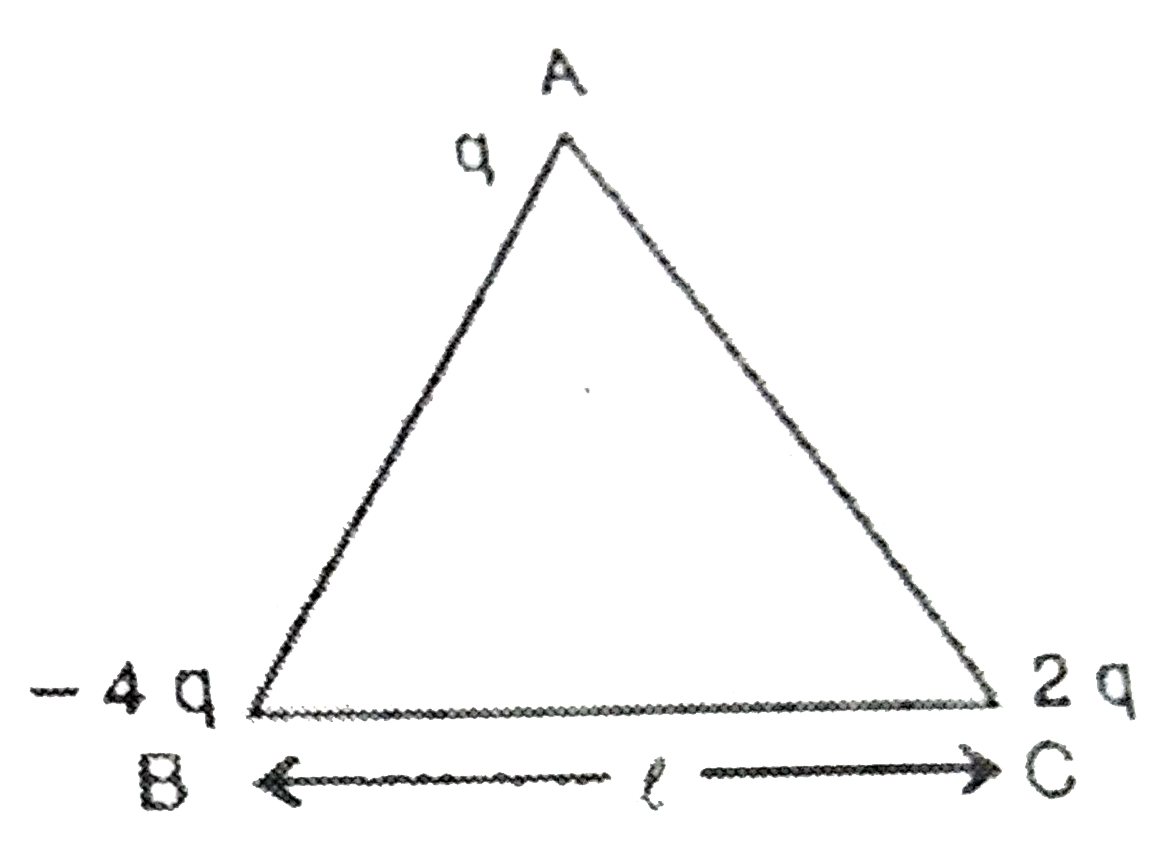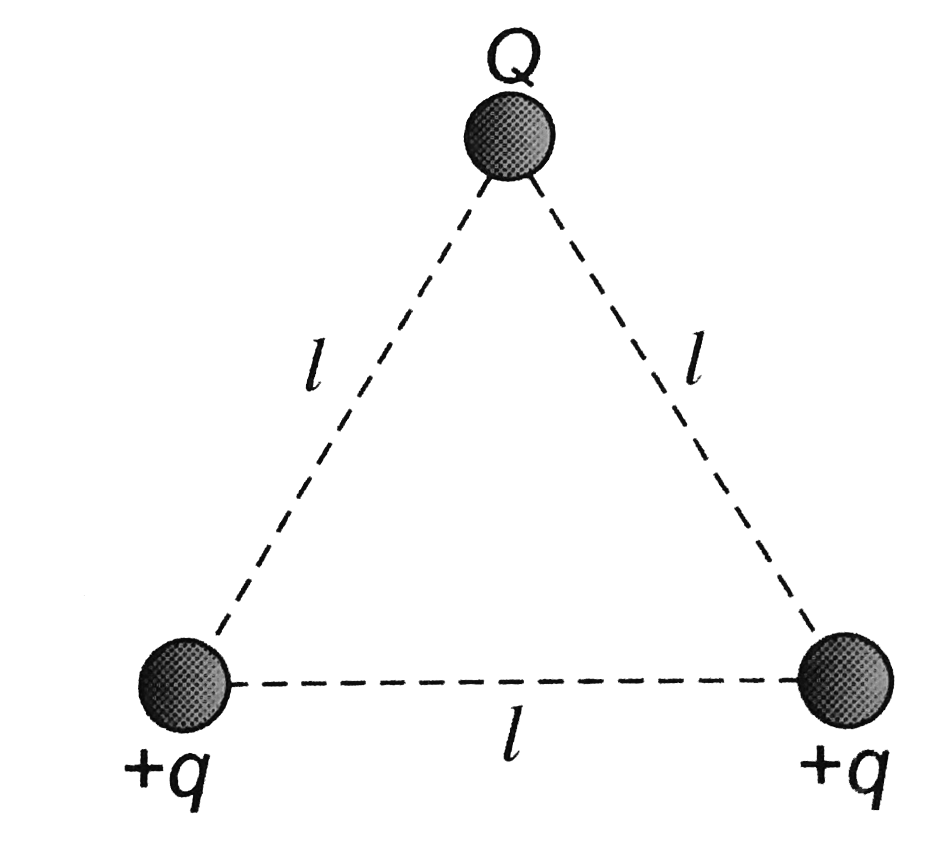Consider the charges q,q and -q placed at the vertices of an equilateral triangle of each side l. What is the force on each charge ?
Let's solve the problem step by step.
Step 1: Understanding the Problem
We have three charges q,q, and −q placed at the vertices of an equilateral triangle with side length l. We need to find the force on each charge.
Step 2: Force on Charge at Vertex 1
Consider the charge q at vertex 1. The forces acting on this charge are due to the charges at vertices 2 and 3.
1. Force due to charge at vertex 2 (q):
- This force is repulsive and acts along the line joining vertices 1 and 2.
- Magnitude of the force F12 is given by Coulomb's law:
F12=kq⋅ql2=kq2l2
2. Force due to charge at vertex 3 (−q):
- This force is attractive and acts along the line joining vertices 1 and 3.
- Magnitude of the force F13 is:
F13=kq⋅(−q)l2=−kq2l2
- Since the force is attractive, we consider the magnitude:
F13=kq2l2
Step 3: Resultant Force on Charge at Vertex 1
The angle between F12 and F13 is 120 degrees (since the internal angle of an equilateral triangle is 60 degrees and the external angle is 120 degrees).
Using the law of cosines for vectors:
F1=√F212+F213+2⋅F12⋅F13⋅cos(120∘)
Substitute the values:
F1=
⎷(kq2l2)2+(kq2l2)2+2⋅(kq2l2)⋅(kq2l2)⋅cos(120∘)
Since cos(120∘)=−12:
F1=√2(kq2l2)2−(kq2l2)2
F1=√(kq2l2)2
F1=kq2l2
Step 4: Force on Charge at Vertex 2
By symmetry, the force on the charge at vertex 2 will be the same as the force on the charge at vertex 1:
F2=kq2l2
Step 5: Force on Charge at Vertex 3
The forces acting on the charge −q at vertex 3 are due to the charges at vertices 1 and 2.
1. Force due to charge at vertex 1 (q):
- This force is attractive and acts along the line joining vertices 3 and 1.
- Magnitude of the force F31 is:
F31=kq⋅(−q)l2=−kq2l2
- Considering the magnitude:
F31=kq2l2
2. Force due to charge at vertex 2 (q):
- This force is attractive and acts along the line joining vertices 3 and 2.
- Magnitude of the force F32 is:
F32=kq⋅(−q)l2=−kq2l2
- Considering the magnitude:
F32=kq2l2
Step 6: Resultant Force on Charge at Vertex 3
The angle between F31 and F32 is 60 degrees.
Using the law of cosines for vectors:
F3=√F231+F232+2⋅F31⋅F32⋅cos(60∘)
Substitute the values:
F3=
⎷(kq2l2)2+(kq2l2)2+2⋅(kq2l2)⋅(kq2l2)⋅cos(60∘)
Since cos(60∘)=12:
F3=√2(kq2l2)2+(kq2l2)2
F3=√3(kq2l2)2
F3=√3⋅kq2l2
Summary
- Force on charge at vertex 1: F1=kq2l2
- Force on charge at vertex 2: F2=kq2l2
- Force on charge at vertex 3: F3=√3⋅kq2l2
We have three charges q,q, and −q placed at the vertices of an equilateral triangle with side length l. We need to find the force on each charge.
Consider the charge q at vertex 1. The forces acting on this charge are due to the charges at vertices 2 and 3.
- This force is repulsive and acts along the line joining vertices 1 and 2.
- Magnitude of the force F12 is given by Coulomb's law:
F12=kq⋅ql2=kq2l2
- This force is attractive and acts along the line joining vertices 1 and 3.
- Magnitude of the force F13 is:
F13=kq⋅(−q)l2=−kq2l2
- Since the force is attractive, we consider the magnitude:
F13=kq2l2
The angle between F12 and F13 is 120 degrees (since the internal angle of an equilateral triangle is 60 degrees and the external angle is 120 degrees).
F1=√F212+F213+2⋅F12⋅F13⋅cos(120∘)
F1=
⎷(kq2l2)2+(kq2l2)2+2⋅(kq2l2)⋅(kq2l2)⋅cos(120∘)
F1=√2(kq2l2)2−(kq2l2)2
F1=√(kq2l2)2
F1=kq2l2
By symmetry, the force on the charge at vertex 2 will be the same as the force on the charge at vertex 1:
F2=kq2l2
The forces acting on the charge −q at vertex 3 are due to the charges at vertices 1 and 2.
- This force is attractive and acts along the line joining vertices 3 and 1.
- Magnitude of the force F31 is:
F31=kq⋅(−q)l2=−kq2l2
- Considering the magnitude:
F31=kq2l2
- This force is attractive and acts along the line joining vertices 3 and 2.
- Magnitude of the force F32 is:
F32=kq⋅(−q)l2=−kq2l2
- Considering the magnitude:
F32=kq2l2
The angle between F31 and F32 is 60 degrees.
F3=√F231+F232+2⋅F31⋅F32⋅cos(60∘)
F3=
⎷(kq2l2)2+(kq2l2)2+2⋅(kq2l2)⋅(kq2l2)⋅cos(60∘)
F3=√2(kq2l2)2+(kq2l2)2
F3=√3(kq2l2)2
F3=√3⋅kq2l2
- Force on charge at vertex 1: F1=kq2l2
- Force on charge at vertex 2: F2=kq2l2
- Force on charge at vertex 3: F3=√3⋅kq2l2
Similar Questions
Consider three charges q1,q2 and q3 each equal to q at the vertices of an equilateral triangle of side 'l' what is the force on any charge due to remaining charges.
View SolutionConsider three charges q1,q2 and q3 each equal to q at the verticles of an equilateral triangle of side 'l' what is the force on any charge due to remianing charges.
View Solution
Knowledge Check
Three charges q1,q2,q3 each equal to q placed at the vertices of an equilateral triangle of side l . What will be the force on a charge Q placed at the centroid of triangle ?
A4NB5NC10NDZeroThree point charges q are placed at three vertices of an equilateral triangle of side a. Find magnitude of electric force on any charge due to the other two.
A(√34πε0)(qa)2B(√24πε0)(qa)2C(√34πε0)(q2a)2D(√24πε0)(2qa)2Charge of 5μC each are placed at the corners of an equilateral triangle of side 10 cm. Then the force on each charge is :-
A78 NB39 NC29 ND22.5 N
(a) Three point charges q,-4q and 2q are placed at the vertices of an equilateral triangle ABC of side 'l' as shown in the figure. Obtain the expression for the magnitude of the resultant electric force acting on the charge q.
(b) Find out the amount of the work done to separate the charges at infinite distance.

View Solution(a) Three point charges q,-4q and 2q are placed at the vertices of an equilateral triangle ABC of side 'l' as shown in the figure. Obtain the expression for the magnitude of the resultant electric force acting on the charge q.
(b) Find out the amount of the work 4one to separate the charges at infinite distance.

View SolutionThree positive charges of equal magnitude q are placed at the vertices of and equilateral triangle of side l. How can the system of charges be placed in equilibrium?
View SolutionThree charges Q,(+q) and (+q) are placed at the vertices of an equilateral triangle of side l as shown in the figure. It the net electrostatic energy of the system is zero, then Q is equal to

View SolutionThree charge −q,+q and −q are placed at the cornors of an equilateral triangle of side a The resultant electric froce an a charge +q placed at a the centroid O of the triangle is
View Solution